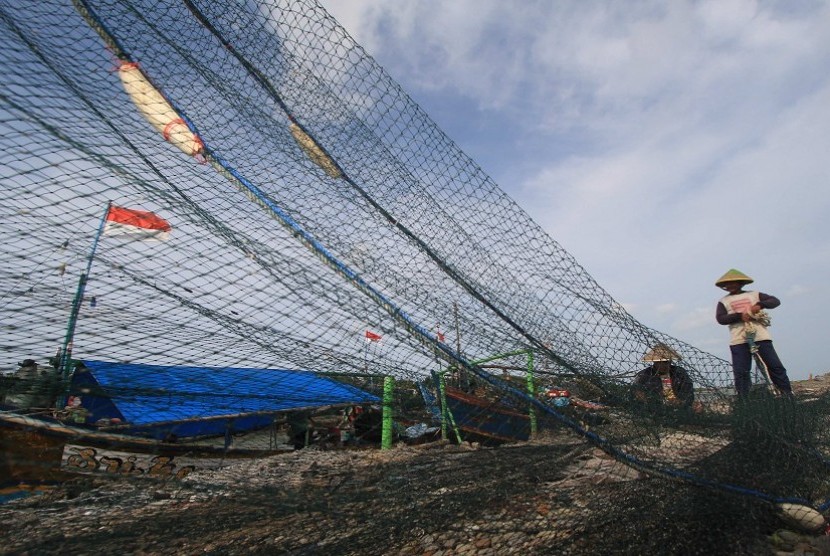REPUBLIKA.CO.ID, JAKARTA -- The government has been urged to legalize the use of cantrang (trawls) as a legitimate fishing tool for fishermen, because the cantrang ban is considered to have a direct impact on the fishermen's economy, particularly in Central Java.
"Fishermen have made optimal efforts to legalize its use. They have met President Joko Widodo (Jokowi) and have filed a lawsuit to the Supreme Court and the Ombudsmen, but unfortunately everything has failed," a member of Commission B of Central Java Regional Legislative Assembly (DPRD), Riyono, stated in a release on Saturday.
According to Riyono, who is also a PKS party politician, the ban is considered to be impartial to fishermen. It has caused loss to around 200 thousand small fishermen, ship laborers, small fish traders, and porters along Central Java coastal areas.
Maritime Affairs and Fisheries Minister Susi Pudjiastuti expressed hope to ban cantrang use as it caused more disadvantages than advantages toward sustainability.
"On the other hand, the replacement of cantrang with promised tools does not match the expectations of fishermen. The promise of providing easy bank loans to fishermen is not easy to be implemented too as it is difficult for them to access banks. Of course, this condition causes fishermen to face more difficulties in the run up to June 19, 2017, when the time allotted for cantrang use will end," he noted.
Riyono, who also served as executive chairman of the Indonesian Fishermen Association (PPNSI), expressed hope that President Joko Widodo would summon Pudjiastuti in order to review the ministerial regulations related to the ban.
Previously, Pudjiastuti banned trawls since the fishing equipment was believed to be causing harm to the marine ecosystem since it was being dragged across the seabed.
"We agree that the trawls are dragged across the seabed and hence, they are destructive," she stated in a written statement.
Pudjiastuti said the use of trawls, locally known as cantrang, could damage the ecosystem, which is a habitat for the organisms that the fish feed on, and could reduce the productivity of the seabed.
Also read: Susi Pudjiastuti explains the danger of trawls to marine ecosystem
The minister pointed out that cantrang could also net several types of fish of varying sizes. Hence, its use runs counter to the principle of sustainability and the Indonesian fishery policy.
"Actually, several fishermen have already switched to using other equipment. Cantrang is no longer used by small fishermen but big players, and several of them also use gillnet and purse seine," she revealed.
To this end, the minister has called on the fishermen to prepare themselves better to adapt to using more environment-friendly equipment.
Sjarief Widjaja, the director general of sea fishing, remarked that the ban on fishing equipment that is not environment-friendly had actually been issued during the government of the late former president Soeharto through Decree No. 39 of 1980.
As a result, fishermen then sought replacements leading to the use of cantrang.
"Initially, cantrang was an environment-friendly fishing equipment, but it was later modified. The permitted cantrang does not use a weight, is not too long, and is usually pulled manually. Cantrangs used nowadays have nets measuring as long as ten to hundred kilometers, weights are attached to the lower edges, and they are pulled using engine power. It is no longer environment friendly," he explained.
Widjaja remarked that cantrangs are generally used by large ships measuring above 30 gross tons (GT).
In 2015, as many as 5,781 cantrangs were being operated across Indonesia. The fisheries and maritime affairs ministry had later replaced 1,529 of them with more environment-friendly equipment, and the process to replace the rest is still ongoing.
Widjaja revealed that the government had not only banned but had also offered solutions, such as providing ships below 10 GT and replacing the fishermen's fishing equipment, to bear the expenses too.
With regard to the procurement of ships weighing 10-30 GT, the government is assisting by providing financing through banks. For ships above 30 GT, the government has prepared fishery management region zones in the east and west -- Arafura and Natuna waters -- that were frequented by foreign ships before.
Pudjiastuti added that the government had offered a grace period of two years to the fishermen to switch over, which they should have utilized well.



